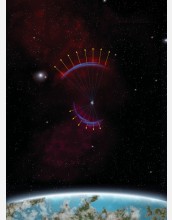News Release 05-212
Blasts from the Past

An artist's concept of a "light echo" from a supernova as seen from Earth
December 21, 2005
This material is available primarily for archival purposes. Telephone numbers or other contact information may be out of date; please see current contact information at media contacts.
An international team of astronomers working at the National Science Foundation's (NSF's) 4-meter telescope at Cerro Tololo Inter-American Observatory (CTIO) in Chile has found visible echoes of three ancient supernovae, according to a report in the Dec. 22 issue of the journal Nature.
The three exploding stars flashed into short-lived brilliance several centuries ago in the Large Magellanic Cloud, a nearby galaxy in Earth's southern skies. The echoes, which take the form of very faint arcs of light centered on the original explosions, represent light that has propagated outward and been reflected back toward Earth by clouds of interstellar gas. They were discovered when the astronomers looked for subtle differences between images of the Large Magellanic Cloud taken years apart.
The astronomers hope to extend this technique to other supernovae, including such famous examples as the one Johannes Kepler observed some 400 years ago. A detailed study of the light echoes could tell the scientists a great deal about each star's death throes and about the nature of the surrounding interstellar medium.
Part of the National Optical Astronomy Observatory, CTIO is operated by the Association of Universities for Research in Astronomy Inc. (AURA), under a cooperative agreement with NSF.
For more information, see the National Optical Astronomy Observatory news release.
-NSF-
-
Geometry of a light echo
Credit and Larger Version
Media Contacts
M. Mitchell Waldrop, NSF, (703) 292-7752, email: mwaldrop@nsf.gov
Douglas Isbell, National Optical Astronomy Observatory, (520) 318-8230, email: disbell@noao.edu
Related Websites
CTIO site: http://www.ctio.noao.edu/
NOAO news release: http://www.noao.edu/outreach/press/pr05/pr0512.html
The U.S. National Science Foundation propels the nation forward by advancing fundamental research in all fields of science and engineering. NSF supports research and people by providing facilities, instruments and funding to support their ingenuity and sustain the U.S. as a global leader in research and innovation. With a fiscal year 2023 budget of $9.5 billion, NSF funds reach all 50 states through grants to nearly 2,000 colleges, universities and institutions. Each year, NSF receives more than 40,000 competitive proposals and makes about 11,000 new awards. Those awards include support for cooperative research with industry, Arctic and Antarctic research and operations, and U.S. participation in international scientific efforts.
Connect with us online
NSF website: nsf.gov
NSF News: nsf.gov/news
For News Media: nsf.gov/news/newsroom
Statistics: nsf.gov/statistics/
Awards database: nsf.gov/awardsearch/
Follow us on social
Twitter: twitter.com/NSF
Facebook: facebook.com/US.NSF
Instagram: instagram.com/nsfgov



